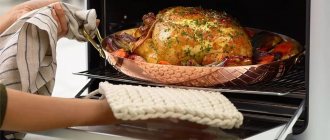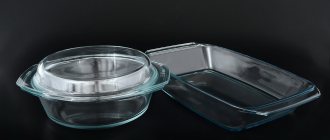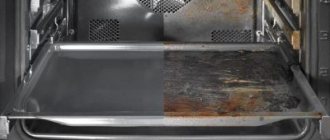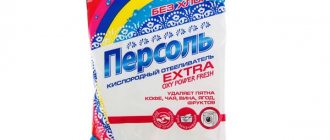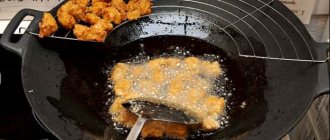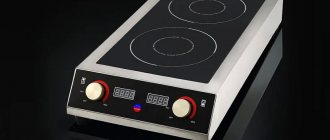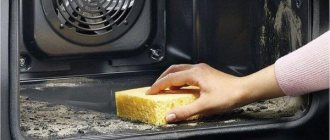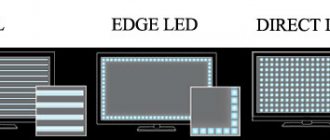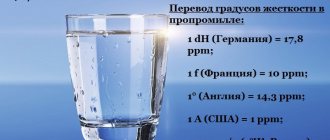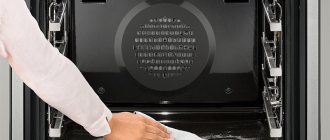The most modern and convenient development for the oven is the pyrolytic cleaning system. This function involves self-cleaning the oven from dirt. This function is present in electric oven models.
The cleaning system is produced by high heating temperature. This means that the oven capsule contains a heater made of durable metal, which heats the entire oven compartment over 460°. As a result, all food residues burn out and turn into ash. As a result, it is enough to remove the remaining debris from the oven box.
During burnout, an unpleasant burning smell is created in the oven, but due to the installed filtration system, it does not penetrate outside. The filter does not need to be cleaned or replaced; its shelf life is designed for the entire period of operation of this equipment.
Brief characteristics of the pyrolytic oven system
An oven with pyrolysis is an advantage of more expensive electric ovens. They are made from crucible steel. The stove door has three-layer, in some cases four-layer, heat-insulating glass.
A brief description of:
- the pyrolysis function in ovens provides ideal self-cleaning ability; in the end, you won’t have to scrub or wash anything;
- the oven cleaning process is performed by a separate independent program;
- During cleaning, the electric oven door is automatically locked and unlocked when the process is completed;
- The electric stove is cleaned within 90-150 minutes.
Pyrolytic cleaning - what is it?
The pyrolytic cleaning function involves increasing the temperature in the oven to 500°C. Hot air burns plaque on the inner surfaces of the oven. This effect turns plaque on the walls and door into a thin film, which can be easily removed with a damp cloth.
Ovens with a pyrolytic cleaning function are produced by such global brands as Bosch, Ariston, Siemens, Miele.
Burning fat and food particles in the oven does not occur without producing smoke and a burning smell. The engineers made sure that smoke did not fill the apartment during cleaning by equipping the oven with a special filter. The manufacturer has provided that the filter be connected to a vent in the kitchen.
In any case, a percentage of the smoke from the oven will leak into the room, so during cleaning, users are advised to turn on the hood or open a window. If you use the function regularly (once a month), less smoke will be released during cleaning.
Ovens with a pyrolytic cleaning function are made of high-strength materials. They are able to withstand high temperatures without undergoing any changes. The factory installs 3 or 4 heat-resistant glasses in the door. In addition, such ovens have additional thermal insulation and a cooling system, which prevents them from heating up outside to critical temperatures.
How to use the pyrolysis function in an oven?
To properly use the pyrolytic cleaning function in the oven, you must:
- Before cleaning, be sure to remove all metal partitions from the oven.
- Turn on the oven self-cleaning button.
- After completing the process, it is necessary to treat all the walls of the oven from the inside.
Important! To remove dust and burnt residues, use a damp cloth. It is recommended to carry out this operation every 100 hours of oven operation.
How has the function of pyrolysis changed over time?
Ovens with a pyrolysis function have evolved significantly since their inception. At the very beginning, models were produced that had 3 cleaning modes:
- Minimum – the fastest, for not too heavy dirt. It takes about 2 hours 15 minutes.
- Normal is the most popular mode, suitable for medium-difficult dirt. Duration - 2 hours 45 minutes.
- Intensive – for the most difficult cases, when a thick coating has formed on the oven walls. It is the longest - 3 hours 15 minutes.
The process itself is divided into the following stages:
- First, the oven is heated to a maximum temperature of 500°C (this takes less than an hour).
- The set temperature is maintained from one to three hours.
- Then the oven cools down.
Over time, manufacturers began to produce ovens, focusing on different consumer needs. Depending on how often housewives use this device, as well as what dishes they prefer to cook in it - vegetables or fatty meats - other cleaning modes have appeared. For example, the so-called “comfort pyrolysis”. It is more suitable for those who rarely use the oven and cook mainly various vegetable dishes or baked goods in it. The entire cleaning process is divided into two stages:
- The oven is preheated to 230°C. At this temperature, pre-firing takes place for the first 30 minutes.
- Then the temperature rises to 500°C, and more intensive cleaning begins, which lasts from one to three hours (depending on how dirty the oven is).
Later, ovens with a pyrolysis function began to be produced with a special catalytic filter, which contains an additional heating element. In such devices, the self-cleaning process proceeds as follows:
- Pre-firing.
- Pyrolysis at maximum temperature. In this case, the additional heating element heats up to 650°C. All organic contaminants that have accumulated in the filter are burned.
- The self-cleaning process ends after the filter has cooled down slightly.
Devices equipped with a catalytic filter are designed to save energy by quickly burning major contaminants.
There is another option for ovens that can significantly reduce power consumption during pyrolytic cleaning. Whirlpool the Sixth Sense sensor system. They capture carbon dioxide, which is released during the combustion of fat and other organic pollutants, and monitor its concentration. As soon as the oven walls are cleaned, the amount of carbon dioxide decreases and the appliance stops working. The pyrolysis process in such models lasts as long as it is really needed, without spending additional energy and time resources.
Positive traits
The pyrolytic purification system has quite a lot of positive qualities. Compared to catalytic and hydrolysis technologies, this is considered more effective.
- No need to use detergents.
- Gets rid of the heaviest contaminants: fat, dairy products, burnt food, etc.
- Cleaning is carried out for the entire interior of the oven. All hard-to-reach areas of the oven chamber are cleaned.
- No additional costs for materials are required: the electric oven has all safety and ventilation systems.
What is pyrolysis?
Pyrolysis is the name given to cleaning a surface from greasy deposits using high temperatures. Ovens equipped with this function can heat up to 500°C (and individual parts - up to 650°C). Unlike catalytic cleaning, which only applies to the side and back walls, during pyrolysis all internal surfaces of the oven are cleaned. Such devices operate only on electricity.
Negative qualities
The pyrolysis function in the oven has a number of disadvantages. The most important of them is the high cost of the stove. Also, an oven with this option does not save the user from additional cleaning; all residues are removed manually.
Unfortunately, the pyrolysis function is only available in electric ovens. The downside to this is that these electronics consume a lot of electricity. And since the pyrolysis option involves heating the oven to a high temperature, electricity will be consumed at the maximum rate.
All oven interiors are cleaned by hand. Racks and trays must be removed during cleaning. And the last disadvantage: the ventilation system does not always cope with its job. Foreign odors may appear both during the self-cleaning period and after opening the oven.
Pyrolytic oven cleaning: principle of operation
Pyrolysis is the process of burning all organic residues that fall on the walls and bottom of the oven during cooking. To do this, the oven is heated to very high temperatures (around 500 ℃). To ensure that equipment can withstand such loads, it is made from high-quality heat-resistant metals and uses technologies that ensure the safety of home use. So, when you turn on the pyrolytic cleaning mode of the oven, the door is blocked and the door is cooled.
Selected models with a multi-level cleaning system ensure pyrolysis at 300 ℃.
During self-cleaning, the outer glass of the door heats up no higher than 55 ℃, and the opening lock is turned off when the temperature inside the chamber drops to 200-250 ℃
The main advantages of pyrolytic ovens:
- pyrolysis most effectively deals with all types of contaminants inside the working chamber, turning them into ash and soot, which can be easily removed with a damp cloth;
- all surfaces are cleaned, including the convector, bottom and inside of the door (unlike catalytic systems);
- do not require cleaning efforts and manual labor;
- designed for long service life.
If the oven is heavily soiled, the process of pyrolytic self-cleaning of the oven may be accompanied by smoke and unpleasant odors.
Ovens with a pyrolytic system are equipped with a built-in catalytic filter that eliminates unpleasant burnt odors. The filter does not require replacement and is cleaned automatically (after every 100 hours of calcination). Many people advise opening a window or turning on forced exhaust ventilation when cleaning the oven.
Do not wait until a thick layer of fat and carbon deposits forms on the walls and bottom of the oven. Carry out pyrolytic cleaning regularly to prevent intense combustion.
Quality ovens with pyrolysis function
Such ovens are famous for their durability. Since the pyrolytic cleaning process is accompanied by very high temperatures, this type of oven is made of high-quality steel, and the walls and bottom inside the device are coated with heat-resistant enamel. Other materials might warp from such extreme temperatures.
The glass on the cabinet door is quite thick. It consists of 3 - 4 (depending on the model) tempered glasses that can withstand intense heat. When making the case, manufacturers take care of thermal insulation and equip such devices with an additional cooling system for the external walls, but still their temperature during pyrolytic cleaning can reach 100°C. Therefore, if you decide to use this function, make sure that children or your pets do not enter the kitchen.
Ovens with pyrolysis are quite safe to use. They are equipped with sensors that monitor the temperature and amount of carbon monoxide. Since fat is highly flammable, ovens are equipped with a system to prevent such situations. The oven door is blocked during pyrolysis. All automation is designed taking into account long-term operation at high temperatures.
Some oven models have special filters that absorb fat. They are located on the convector grille and are designed to protect the surface of the fan from dirt that could interfere with its operation.
The enamel that covers the inner walls of the ovens is very smooth and durable. If you don't want to waste energy, you can clean it using various detergents (which is not recommended for ovens with catalytic panels).
Advantages and disadvantages
To understand whether you need to overpay for an oven with a pyrolysis function, you need to find out all the pros and cons of this cleaning method.
The advantages of the latter include the following:
- all types of contaminants are burned;
- no need to replace consumables;
- such ovens are self-cleaning;
- no need to use specialized products for cleaning;
- no foreign odors arise during cleaning;
- after starting this function, the entire area of the internal walls is simultaneously cleaned.
Among the disadvantages of ovens with pyrolytic cleaning are the following:
- Baking trays and racks must be cleaned separately;
- such equipment is more expensive than other oven models;
- After processing, you need to manually remove the ash;
- pyrolysis is only available for electric ovens;
- lack of automatic cleaning mode;
- increased energy consumption.
Despite the above, the pyrolytic method is increasingly popular. This is partly due to the fact that such cleaning requires no more than one hour.
| Cleaning method | pros | Minuses |
| Hydrolytic | Low price | Not effective against old stains |
| Low power consumption | To remove some types of contaminants you need to use specialized products | |
| Suitable for gas stoves | After the procedure, you need to manually clean the walls | |
| Takes no more than half an hour | Unpleasant odors occur after starting the function | |
| Can be cleaned together with dishes, baking trays and wire racks | ||
| Catalytic | The walls are cleaned during cooking | Short service life of panels that need to be replaced every 3–5 years |
| Suitable for any type of slab | The bottom and doors must be cleaned by hand | |
| Pyrolytic | Removes all types of dirt | Trays and racks must not be cleaned |
| No need to use specialized cleaning agents | Increased energy consumption | |
| There are no foreign odors after starting cleaning | Suitable for electric ovens only | |
| All internal surfaces are cleaned at the same time | The equipment is more expensive than other types of ovens |
Oven with catalysis: cooking and cleaning
Catalytic ovens, convenient cleaning and time saving, but with the need to change components. The catalytic cleaning oven is mainly distinguished by the design of the internal space. Removable catalytic panels are attached to the walls. On which a special composition is applied. This is what cleans the oven. The composition is a porous material. These pores contain a special substance that absorbs dirt. Because of this, the oven takes on a somewhat unusual appearance. And the walls are noticeably rough to the touch. This technique allows the oven to clean itself even while cooking. At the same time, the dishes do not acquire any harmful properties or unpleasant odors.
Typically, temperatures above 140°C are required to activate the process. In the pores, contaminants are broken down into simple, harmless substances. They can then be easily wiped with a damp cloth. The panels themselves have a certain service life. And they have to be changed approximately every 5 years. Available in single-sided and double-sided versions. Determining whether the panel needs to be replaced is quite easy. This will be noticeable by the accumulation of contaminants. The replacement itself can be done independently and at home. Usually you literally need to unscrew a couple of bolts according to the instructions.
Benefits of catalytic cleaning
- the outer walls heat up in the same way as in conventional ovens;
- saving time due to cleaning at the time of cooking;
- Can also be used for gas ovens.
Disadvantages of catalytic purification
- availability of consumables – catalytic panels;
- it is also necessary to clean removable elements separately;
- The panels are not installed on the door; it must be cleaned using the standard method;
- For complex stains, several procedures are required.
See also -
Pros and cons of an oven with catalytic cleaning
